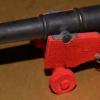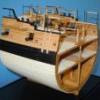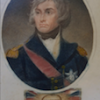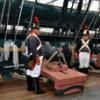-
Posts
1,763 -
Joined
-
Last visited
Reputation Activity
-

-
 Mark P got a reaction from dvm27 in Caroline's bottom
Mark P got a reaction from dvm27 in Caroline's bottom
Hi Grant;
'White stuff' was used to cover the ship's hull below the waterline. It was intended for use in the tropics, where the shipworms were more active. It was more expensive than the 'black stuff' which was used for ships in European waters. However, most models depict the ships with a white bottom, as it is much more attractive.
In the case of the Royal Caroline, she is shown in several paintings by John Cleveley the Elder, and where her underwater hull is visible, it is white. As Cleveley was renowned for the accuracy of his paintings (also, he was a former shipwright at Deptford Dockyard, and was there at the time that Royal Caroline was built there) I would take that as sufficient authority to paint her bottom white.
As for coppering, this was only introduced widely in the early 1780s, so would not have been used at the time of Royal Caroline's launch or for much of her career (not until after she was re-named the Royal Charlotte in 1761)
All the best,
Mark P
-
 Mark P got a reaction from mtaylor in Caroline's bottom
Mark P got a reaction from mtaylor in Caroline's bottom
Hi Grant;
'White stuff' was used to cover the ship's hull below the waterline. It was intended for use in the tropics, where the shipworms were more active. It was more expensive than the 'black stuff' which was used for ships in European waters. However, most models depict the ships with a white bottom, as it is much more attractive.
In the case of the Royal Caroline, she is shown in several paintings by John Cleveley the Elder, and where her underwater hull is visible, it is white. As Cleveley was renowned for the accuracy of his paintings (also, he was a former shipwright at Deptford Dockyard, and was there at the time that Royal Caroline was built there) I would take that as sufficient authority to paint her bottom white.
As for coppering, this was only introduced widely in the early 1780s, so would not have been used at the time of Royal Caroline's launch or for much of her career (not until after she was re-named the Royal Charlotte in 1761)
All the best,
Mark P
-
 Mark P got a reaction from Canute in Greenwich Hospital barge of 1832 by druxey - FINISHED - 1:48 scale
Mark P got a reaction from Canute in Greenwich Hospital barge of 1832 by druxey - FINISHED - 1:48 scale
Hi Druxey;
I'm with everyone else on this. A fine inspiration to all, and a very informative, instructive and pleasure-to-read build log, with a lovely model at the end of the trail!
All the best, and many thanks for taking the trouble to share this.
Mark P
-

-
 Mark P got a reaction from mtaylor in Caroline's bottom
Mark P got a reaction from mtaylor in Caroline's bottom
Hi Druxey;
I have never heard of that one. I will keep an eye out for any references in the future.
All the best,
Mark P
-
 Mark P got a reaction from mtaylor in Greenwich Hospital barge of 1832 by druxey - FINISHED - 1:48 scale
Mark P got a reaction from mtaylor in Greenwich Hospital barge of 1832 by druxey - FINISHED - 1:48 scale
Hi Druxey;
I'm with everyone else on this. A fine inspiration to all, and a very informative, instructive and pleasure-to-read build log, with a lovely model at the end of the trail!
All the best, and many thanks for taking the trouble to share this.
Mark P
-
 Mark P got a reaction from EJ_L in Caroline's bottom
Mark P got a reaction from EJ_L in Caroline's bottom
Hi Grant;
'White stuff' was used to cover the ship's hull below the waterline. It was intended for use in the tropics, where the shipworms were more active. It was more expensive than the 'black stuff' which was used for ships in European waters. However, most models depict the ships with a white bottom, as it is much more attractive.
In the case of the Royal Caroline, she is shown in several paintings by John Cleveley the Elder, and where her underwater hull is visible, it is white. As Cleveley was renowned for the accuracy of his paintings (also, he was a former shipwright at Deptford Dockyard, and was there at the time that Royal Caroline was built there) I would take that as sufficient authority to paint her bottom white.
As for coppering, this was only introduced widely in the early 1780s, so would not have been used at the time of Royal Caroline's launch or for much of her career (not until after she was re-named the Royal Charlotte in 1761)
All the best,
Mark P
-
 Mark P got a reaction from druxey in Caroline's bottom
Mark P got a reaction from druxey in Caroline's bottom
Hi Grant;
'White stuff' was used to cover the ship's hull below the waterline. It was intended for use in the tropics, where the shipworms were more active. It was more expensive than the 'black stuff' which was used for ships in European waters. However, most models depict the ships with a white bottom, as it is much more attractive.
In the case of the Royal Caroline, she is shown in several paintings by John Cleveley the Elder, and where her underwater hull is visible, it is white. As Cleveley was renowned for the accuracy of his paintings (also, he was a former shipwright at Deptford Dockyard, and was there at the time that Royal Caroline was built there) I would take that as sufficient authority to paint her bottom white.
As for coppering, this was only introduced widely in the early 1780s, so would not have been used at the time of Royal Caroline's launch or for much of her career (not until after she was re-named the Royal Charlotte in 1761)
All the best,
Mark P
-
 Mark P reacted to JerseyCity Frankie in Using a server with dead eyes, standing rigging
Mark P reacted to JerseyCity Frankie in Using a server with dead eyes, standing rigging
It sounds like you are planning on serving the shrouds with one continuous thread from end to end? Don't worry about using a singe thread, even in actual practice the serving can go on in multiple pieces- when the serving gets too short you start a new piece of serving and serve over the last bit of the old piece and continue on down the shroud or stay. Also it sounds almost as if you are thinking of the serving as performing the duel function of being the lanyard that tightens the deadeyes? This is NEVER the case. The serving is made of the thinnest thread you can find and is entirely independent of the much thicker line used to lace the upper and lower deadeyes together. This heavier line is called the Lanyard and is only long enough to run through all the holes in the deadeyes with a little left over to make fast the end above the upper deadeye with a few hitches. And to answer your question you lace the lanyard through the deadeyes LAST of all the other operations with attaching the shrouds. In fact its best to NOT glue or in any other way decisively fix the lanyards until you are done rigging the rest of the model- as you rig more on the ship, the lower shrouds often need last minute tension adjustment and only when everything is JUST RIGHT should you put a drop of glue on the Lanyards.
-
 Mark P got a reaction from alangr4 in Rogers, Sergison, Pepys Collections
Mark P got a reaction from alangr4 in Rogers, Sergison, Pepys Collections
Hi Alan;
The Sergison and Rogers collection are the same thing. It belonged to Charles Sergison's descendants before Colonel Rogers bought it, from under the nose of R C Anderson, who was really miffed that he had not been informed of the sale before it was completed.
The Pepys collection is a manuscript collection in Magdalen College, Cambridge, and contains no models.
Charles Sergison was Clerk of the Accounts at the Admiralty in the late 17th century, and laid the basis for the collection before he died in 1719. It remained in his family at Cuckfield Park, until Rogers bought it. Sergison inherited Pepys's models when the latter died.
all the best,
Mark P
-
 Mark P got a reaction from popeye2sea in What style of cradle was used in the 17th century for ships like the Mary Rose when in dry dock?
Mark P got a reaction from popeye2sea in What style of cradle was used in the 17th century for ships like the Mary Rose when in dry dock?
Hi Bear;
Those are some very realistic-looking timbers you've made there. Congratulations! Balsa wood is a very good idea for them, so that the soft grain can be brushed away.
That's one to file away in the old memory for use if I ever build a dock of any sort.
All the best,
Mark P
-
 Mark P got a reaction from Altduck in What style of cradle was used in the 17th century for ships like the Mary Rose when in dry dock?
Mark P got a reaction from Altduck in What style of cradle was used in the 17th century for ships like the Mary Rose when in dry dock?
Hi Bear;
Those are some very realistic-looking timbers you've made there. Congratulations! Balsa wood is a very good idea for them, so that the soft grain can be brushed away.
That's one to file away in the old memory for use if I ever build a dock of any sort.
All the best,
Mark P
-
 Mark P got a reaction from mtaylor in What style of cradle was used in the 17th century for ships like the Mary Rose when in dry dock?
Mark P got a reaction from mtaylor in What style of cradle was used in the 17th century for ships like the Mary Rose when in dry dock?
Hi Bear;
Those are some very realistic-looking timbers you've made there. Congratulations! Balsa wood is a very good idea for them, so that the soft grain can be brushed away.
That's one to file away in the old memory for use if I ever build a dock of any sort.
All the best,
Mark P
-
 Mark P reacted to bear in What style of cradle was used in the 17th century for ships like the Mary Rose when in dry dock?
Mark P reacted to bear in What style of cradle was used in the 17th century for ships like the Mary Rose when in dry dock?
Thanks Mark for setting me straight on the types listed.
Keel blocks it will be. Here's what I have made up today for the dry dock.
Ties will be set with rock around them up to within 1/16" of the top of the tie's. They are 1/4" square balsa strips that I cut to random lenghts and then I added the wood grain and stressed areas to them. I painted them with a grey wash.
The rocks-model railroad ballast will be brown and grey mixed.
With the keel blocks and then the props will be added on outside the width of the base now for added width at a later date.
I added the wood grain and distress to the ties with an xacto knife and wire brush. I had different harness of balsa strips,so they made the wash look different in color without having to change the wash color itself.
Keith
-
 Mark P got a reaction from Tadeusz43 in What style of cradle was used in the 17th century for ships like the Mary Rose when in dry dock?
Mark P got a reaction from Tadeusz43 in What style of cradle was used in the 17th century for ships like the Mary Rose when in dry dock?
Hi Keith;
I don't know much about launching or docks in the early years of the 16th Century, but if Mary Rose was built in a dry dock, then if later practice is a guide to that of earlier periods, she would not have been in cradles. A ship in dry dock was supported with a line of blocks below the keel, and rows of props against the side of the dock to keep her upright. For launching, the dock was filled on a rising tide, and the ship was floated out.
Cradles were used on a slipway, which had a bottom that sloped down to the river, and ships were launched by sliding them into the water, with the ship in two cradles which slid on timber rails.
All the best,
Mark P
-
 Mark P got a reaction from mtaylor in What style of cradle was used in the 17th century for ships like the Mary Rose when in dry dock?
Mark P got a reaction from mtaylor in What style of cradle was used in the 17th century for ships like the Mary Rose when in dry dock?
Hi Keith;
I don't know much about launching or docks in the early years of the 16th Century, but if Mary Rose was built in a dry dock, then if later practice is a guide to that of earlier periods, she would not have been in cradles. A ship in dry dock was supported with a line of blocks below the keel, and rows of props against the side of the dock to keep her upright. For launching, the dock was filled on a rising tide, and the ship was floated out.
Cradles were used on a slipway, which had a bottom that sloped down to the river, and ships were launched by sliding them into the water, with the ship in two cradles which slid on timber rails.
All the best,
Mark P
-
 Mark P reacted to Dwaing in Ammoniated water
Mark P reacted to Dwaing in Ammoniated water
I think what you need is a surfactant to make the water wetter so it penetrates more deeply into the wood (xylem cells). I use a common household product call "clean shower" as a 1:10 solution dissolved in distilled water.
-
 Mark P reacted to jud in Ammoniated water
Mark P reacted to jud in Ammoniated water
Anhydrous Ammonia is stored under pressure because it is gaseous at atmospheric pressure, containers may burst, but by itself will not explode. Years ago Aqua Ammonia was used for fertilizer and other things, went out of favor for farm use because of the mass. The last Ammonia I bought was in a liquid form, not under pressure and came in gallon plastic jugs, 4 to a case which was the minimum you could purchase and have shipped as hazardous material, that freight cost about 5 times more than the case of ammonia did. Needed it as a developer for my blue print machine, still have 2 unopened jugs left. Ammonia regardless of form is not an explosive or fire hazard but it can hurt or kill you if precautions are not taken, it displaces air and will form a cloud that burns your eyes and leaves you with no air to breath, the Aqua you can just move away from unless a lot is atomized quickly, the Anhydrous, being under pressure until released can burn you, 'actually frost bite', burn your lungs and eyes as well as displace your air. Every applicator I have been around is equipped with an emergency water eye rinse. Have used ag applicators to inject a lot of it into the soil as fertilizer, turns into nitrogen in the soil which can be made to explode in some forms but not in the soil as used for fertilizer. Those machines have a lanyard and valve used to pre-charge the system so skips aren't made when first starting from a stop, if not careful using it, you quickly learn about overdoing it as well as to keep the machine down wind if you can. If you need a small bit of ammonia, might try peeing on your board.
jud
-
 Mark P reacted to druxey in chisels
Mark P reacted to druxey in chisels
It's not so much the brand of chisel, but how well it's sharpened that matters. I use a Lee Valley (Veritas) sharpening system with their jig and stone pond. I have water stones of 1000 and 4000 grit and add a micro-bevel on the edge. The back of the chisel is also polished to a mirror finish. Cutting with a well-sharpened edge produces the sound of a fresh apple being cut and beautiful shavings.
-
 Mark P got a reaction from Keith_W in Help in Identifying an Unknown Tool
Mark P got a reaction from Keith_W in Help in Identifying an Unknown Tool
Hi Pat;
Over here in England, that is what we call a mortice guage. As Rick says above, it is missing a block. This block could be moved independently of the pins, so that either one pin is just tucked into the face of the block, in which case only one pin scribes a line, or it can be set away from both pins, so that a double line can be scribed.
Without the pins and the block, it is probably only good for a small vice, as you say.
All the best,
Mark
-
 Mark P got a reaction from druxey in Help in Identifying an Unknown Tool
Mark P got a reaction from druxey in Help in Identifying an Unknown Tool
Hi Pat;
Over here in England, that is what we call a mortice guage. As Rick says above, it is missing a block. This block could be moved independently of the pins, so that either one pin is just tucked into the face of the block, in which case only one pin scribes a line, or it can be set away from both pins, so that a double line can be scribed.
Without the pins and the block, it is probably only good for a small vice, as you say.
All the best,
Mark
-
 Mark P got a reaction from mtaylor in Help in Identifying an Unknown Tool
Mark P got a reaction from mtaylor in Help in Identifying an Unknown Tool
Hi Pat;
Over here in England, that is what we call a mortice guage. As Rick says above, it is missing a block. This block could be moved independently of the pins, so that either one pin is just tucked into the face of the block, in which case only one pin scribes a line, or it can be set away from both pins, so that a double line can be scribed.
Without the pins and the block, it is probably only good for a small vice, as you say.
All the best,
Mark
-
 Mark P got a reaction from Canute in Help in Identifying an Unknown Tool
Mark P got a reaction from Canute in Help in Identifying an Unknown Tool
Hi Pat;
Over here in England, that is what we call a mortice guage. As Rick says above, it is missing a block. This block could be moved independently of the pins, so that either one pin is just tucked into the face of the block, in which case only one pin scribes a line, or it can be set away from both pins, so that a double line can be scribed.
Without the pins and the block, it is probably only good for a small vice, as you say.
All the best,
Mark
-
 Mark P got a reaction from WackoWolf in Help in Identifying an Unknown Tool
Mark P got a reaction from WackoWolf in Help in Identifying an Unknown Tool
Hi Pat;
Over here in England, that is what we call a mortice guage. As Rick says above, it is missing a block. This block could be moved independently of the pins, so that either one pin is just tucked into the face of the block, in which case only one pin scribes a line, or it can be set away from both pins, so that a double line can be scribed.
Without the pins and the block, it is probably only good for a small vice, as you say.
All the best,
Mark













